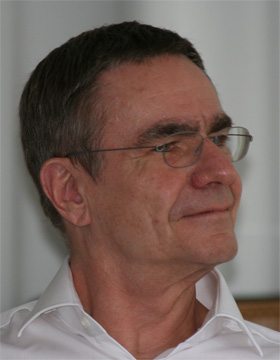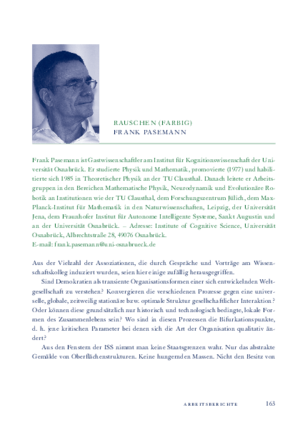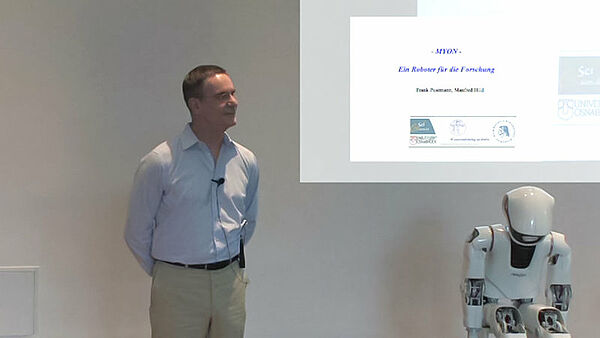
Frank Pasemann, Dr. rer. nat. habil.
Apl. Professor für Theoretische Physik
Universität Osnabrück
Born in 1943, Schneidemühl, now Pila, Poland
Studied Physics and Mathematics at the Philipps-Universität Marburg
Schwerpunkt
Funktionelle und strukturelle Randbedingungen bei der Evolution sensomotorischer Netzwerke
Arbeitsvorhaben
Neuronale Bewegungskontrolle
The project approaches the problem of locomotion from the perspective of embodied systems. According to the central tenet of this approach, brain processes in general and - on the lowest level - motor control in particular should be described, analysed and theorised under the assumption that these processes emerge from brain-body-environment interactions.For locomotion, rhythmic activity patterns appear naturally. A theory will therefore start from a Dynamical Systems perspective. The challenging part of this approach results from the fact that neural control has to operate in the sensorimotor loop, where external sensor signals as well as internal sensor signals will continuously drive the dynamics of control units. On this background the project will focus on two aspects:
1) Rhythmic neural activity patterns can be generated in at least two different ways: First, they can appear as the intrinsic dynamics of specific neural structures functioning as CPGs; i. e. they oscillate already as isolated neural systems. But rhythmic activity patterns are generated also in shorter or longer (reflex) feedback loops. The subject to study is the interplay of CPG and reflex loop functionality in concrete behavioural tasks for animals and/or animats.
2) Discerning between external and internal signal loops, reflecting the difference between perception and proprioception, the second aspect concentrates on the interdependencies between these signal lines and on their role for the modulation and switching of behaviours.
Staying in the context of embodiment, the conceptual framing and the derived theoretical results will be tested on physical robots or by using physical simulations of e. g. multi-legged walking machines.
Recommended Reading
Pasemann, Frank 1996. "Repräsentation ohne Repräsentation - Überlegungen zu einer Neurodynamik modularer kognitiver Systeme." In Interne Repräsentationen - Neue Konzepte der Hirnforschung, edited by G. Rusch, S. J. Schmidt, and O. Breidbach, 42-91. Frankfurt: Suhrkamp.
__. 2002. "Complex dynamics and the structure of small neural networks." Network: Computation in Neural Systems 13: 195-216.
Kolloquium, 24.11.2009
Verkörperte Kognition, evolutionäre Robotik und die Neurodynamik der Verhaltenskontrolle
Der noch junge Forschungszweig der evolutionären Robotik ist von genuin interdisziplinärem Charakter. Er bezieht Denkansätze, Fragestellungen und Forschungsergebnisse u.a. aus den Bereichen der Neurowissenschaften, der Kognitionswissenschaft, der Informatik und der Robotik in seine Untersuchungen ein. Mit Hilfe von evolutionären Computerprogrammen werden verschiedene Ziele, oft gleichzeitig, verfolgt. So werden z.B. Lösungen von real-weltlichen (kognitiven) Verhaltensleistungen von Robotern gesucht, aber auch spezifische Eigenschaften einer Theorie der Evolution untersucht. Zentral jedoch ist in dem hier vorgetragenen Zusammenhang der Versuch, vermöge einer Analyse der evolutionär entstandenen künstlichen neuronalen Systeme zu einem tieferen Verständnis verhaltensrelevanter Signalverarbeitung in biologischen Systemen zu gelangen.
Das Projekt der Arbeitsgruppe bezieht sich primär auf die "Evolution sensomotorischer Netzwerke". Dennoch werde ich zunächst die evolutionäre Robotik vor dem Hintergrund verschiedener Ansätze zur Beschreibung von biologischen Nervensystemen und ihrer kognitiven Fähigkeiten einführen. Dies sind z.B. Kybernetik, künstliche Intelligenz ," Embodiment" und " Situatedness", künstliche neuronale Netze, dynamische Systeme. Da eine meiner Grundannahmen ist, dass kognitive Fähigkeiten wesentlich auf dynamischen Eigenschaften des zu Grunde liegenden (biologischen oder künstlichen) Substrats beruhen, wird eine knappe Übersicht über Eigenschaften der Neurodynamik gegeben. Eine weitere Annahme besagt, dass die hier zu untersuchenden kognitiven Fähigkeiten wesentlich für ein lebenserhaltendes Verhalten sind. Dies legt einen sog. " Artificial Life"-Ansatz zur evolutionären Robotik nahe. Einige typische Ergebnisse, die mit Hilfe dieser Methoden erzielt wurden, werden vorgestellt. Abschließend werde ich insbesondere auf die neuronale Kontrolle von mehrbeinigen Laufmaschinen eingehen.
Publikationen aus der Fellowbibliothek
Pasemann, Frank (Berlin, Heidelberg, 2011)
Pasemann, Frank ([S.l.], 2010)
Search space restriction of neuro-evolution through constrained modularization of neural networks
Pasemann, Frank (2008)
Yars : a physical 3D simulator to evolve controllers for real robots
Pasemann, Frank (2008)
Pasemann, Frank (2008)
Attractor landscapes and active tracking : the neurodynamics of embodied action
Pasemann, Frank (2007)
Transients of active tracking : a stroll in attractor spaces
Pasemann, Frank (2007)
Reactive neural control for phototaxis and obstacle avoidance behavior of walking machines
Pasemann, Frank (2007)
Pasemann, Frank (2007)
Cooperation and competition : neural mechanisms of evolved communication systems
Pasemann, Frank (2007)
Reflex-oscillations in evolved single leg neurocontrollers for walking machines

